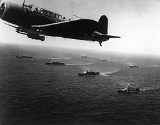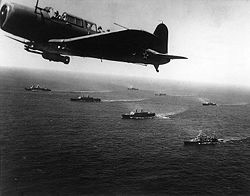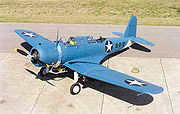
SB2U Vindicator
Encyclopedia
The Vought SB2U Vindicator was a carrier
-based dive bomber
developed for the United States Navy
in the 1930s, the first monoplane
in this role. Obsolescent at the outbreak of World War II
, Vindicators still remained in service at the time of the Battle of Midway
, but by 1943, all had been withdrawn to training units. It was known as the Chesapeake in Royal Navy
service.
issued a requirement for a new Scout Bomber for carrier use, and received proposals from six manufacturers. The specification was issued in two parts, one for a monoplane
, and one for a biplane
. Vought
submitted designs in both categories, which would become the XSB2U-1 and XSB3U-1
respectively. The biplane was considered alongside the monoplane design as a "hedge" against the U.S. Navy's reluctance to pursue the modern configuration.
The XSB2U-1 was of conventional low-wing monoplane configuration, with a retractable tailwheel undercarriage
and the pilot and tail gunner seated in tandem under a long greenhouse-style canopy. The fuselage
was of steel tube construction, covered with aluminum panels from the nose to the rear cockpit, and with a fabric covered rear fuselage, while the folding cantilever wing was of all-metal construction. A Pratt & Whitney R-1535
Twin-Wasp Junior radial engine
drove a two-blade constant-speed propeller, which was intended to act as a dive-brake during a dive bombing attack. A single 1,000 lb (450 kg) bomb could be carried on a swinging trapeze to allow it to clear the propeller in a steep dive, while further bombs could be carried under the wings to give a maximum bombload of 1,500 lb (680 kg).
The SB2U was evaluated against the Brewster XSBA-1, Curtiss XSBC-3, Great Lakes XB2G-1, Grumman XSBF-1 and Northrop XBT-1
. All but the Great Lakes
and Grumman submissions were ordered into production. Designated XSB2U-1, one prototype was ordered on 15 October 1934 and was delivered on 15 April 1936. Accepted for operational evaluation on 2 July 1936, the prototype XSB2U-1, BuNo 9725, crashed on 20 August 1936. Its successful completion of trials led to further orders.
There were 260 examples of all Vindicator variants produced, and a single example is preserved at the National Museum of Naval Aviation
at NAS Pensacola.

_in_san_diego_harbor,_1942.jpg) Vindicators served on four carriers, , , , and between December 1937 and September 1942. Air Group Nine, destined for , trained in Vindicators aboard the auxiliary carrier but transitioned to the SBD Dauntless
Vindicators served on four carriers, , , , and between December 1937 and September 1942. Air Group Nine, destined for , trained in Vindicators aboard the auxiliary carrier but transitioned to the SBD Dauntless
before Essex joined the war.
started. AB 1 sustained heavy losses while attacking bridges and German ground targets in Northern France, while AB 3's V-156-Fs were briefly engaged against the Italians. By the time of the Armistice
, there were only a handful of remaining Voughts in French hands, and the type was phased out of service.
's Fleet Air Arm
, who named the aircraft the Chesapeake. The British required several modifications to the Chesapeake, including the additional fuel tank fitted to the SB2U-3, additional armour and heavier forward firing armament, with four rifle calibre machine guns replacing the single forward firing Darne machine gun of the French aircraft. Fourteen Chesapeakes were used to used to equip a reformed 811 Naval Air Squadron on 14 July 1941. The squadron, whose crews referred to it as the "cheesecake", was intended to use them for anti-submarine patrols and was earmarked for the escort carrier
.
By the end of October that year, it had been decided that the Chesapeakes were under-powered for the planned duties and would not be able to lift a sensible warload from the small escort carriers. Accordingly, they were withdrawn from 811 Squadron in November 1941 for use as training aircraft and the unit was re-equipped with the biplane Fairey Swordfish
.
SB2U-1
SB2U-2
XSB2U-3
SB2U-3
V-156F-3
V-156B-1

Aircraft carrier
An aircraft carrier is a warship designed with a primary mission of deploying and recovering aircraft, acting as a seagoing airbase. Aircraft carriers thus allow a naval force to project air power worldwide without having to depend on local bases for staging aircraft operations...
-based dive bomber
Dive bomber
A dive bomber is a bomber aircraft that dives directly at its targets in order to provide greater accuracy for the bomb it drops. Diving towards the target reduces the distance the bomb has to fall, which is the primary factor in determining the accuracy of the drop...
developed for the United States Navy
United States Navy
The United States Navy is the naval warfare service branch of the United States Armed Forces and one of the seven uniformed services of the United States. The U.S. Navy is the largest in the world; its battle fleet tonnage is greater than that of the next 13 largest navies combined. The U.S...
in the 1930s, the first monoplane
Monoplane
A monoplane is a fixed-wing aircraft with one main set of wing surfaces, in contrast to a biplane or triplane. Since the late 1930s it has been the most common form for a fixed wing aircraft.-Types of monoplane:...
in this role. Obsolescent at the outbreak of World War II
World War II
World War II, or the Second World War , was a global conflict lasting from 1939 to 1945, involving most of the world's nations—including all of the great powers—eventually forming two opposing military alliances: the Allies and the Axis...
, Vindicators still remained in service at the time of the Battle of Midway
Battle of Midway
The Battle of Midway is widely regarded as the most important naval battle of the Pacific Campaign of World War II. Between 4 and 7 June 1942, approximately one month after the Battle of the Coral Sea and six months after Japan's attack on Pearl Harbor, the United States Navy decisively defeated...
, but by 1943, all had been withdrawn to training units. It was known as the Chesapeake in Royal Navy
Royal Navy
The Royal Navy is the naval warfare service branch of the British Armed Forces. Founded in the 16th century, it is the oldest service branch and is known as the Senior Service...
service.
Design and development
In 1934, the United States NavyUnited States Navy
The United States Navy is the naval warfare service branch of the United States Armed Forces and one of the seven uniformed services of the United States. The U.S. Navy is the largest in the world; its battle fleet tonnage is greater than that of the next 13 largest navies combined. The U.S...
issued a requirement for a new Scout Bomber for carrier use, and received proposals from six manufacturers. The specification was issued in two parts, one for a monoplane
Monoplane
A monoplane is a fixed-wing aircraft with one main set of wing surfaces, in contrast to a biplane or triplane. Since the late 1930s it has been the most common form for a fixed wing aircraft.-Types of monoplane:...
, and one for a biplane
Biplane
A biplane is a fixed-wing aircraft with two superimposed main wings. The Wright brothers' Wright Flyer used a biplane design, as did most aircraft in the early years of aviation. While a biplane wing structure has a structural advantage, it produces more drag than a similar monoplane wing...
. Vought
Vought
Vought is the name of several related aerospace firms. These have included, in the past, Lewis and Vought Corporation, Chance Vought, Vought Sikorsky, LTV Aerospace , Vought Aircraft Companies, and the current Vought Aircraft Industries. The first incarnation of Vought was established by Chance M...
submitted designs in both categories, which would become the XSB2U-1 and XSB3U-1
SBU Corsair
-References:*Swanborough, Gordon and Bowers, Peter M. United States Navy Aircraft since 1911. London:Putnam, 1976. ISBN 0 370 10054 9....
respectively. The biplane was considered alongside the monoplane design as a "hedge" against the U.S. Navy's reluctance to pursue the modern configuration.
The XSB2U-1 was of conventional low-wing monoplane configuration, with a retractable tailwheel undercarriage
Conventional landing gear
thumb|The [[Piper PA-18|Piper Super Cub]] is a popular taildragger aircraft.thumb|right|A [[Cessna 150]] converted to taildragger configuration by installation of an after-market modification kit....
and the pilot and tail gunner seated in tandem under a long greenhouse-style canopy. The fuselage
Fuselage
The fuselage is an aircraft's main body section that holds crew and passengers or cargo. In single-engine aircraft it will usually contain an engine, although in some amphibious aircraft the single engine is mounted on a pylon attached to the fuselage which in turn is used as a floating hull...
was of steel tube construction, covered with aluminum panels from the nose to the rear cockpit, and with a fabric covered rear fuselage, while the folding cantilever wing was of all-metal construction. A Pratt & Whitney R-1535
Pratt & Whitney R-1535
|-See also:* Pratt & Whitney Wasp series* R-985 Wasp Junior* R-1340 Wasp* R-1830 Twin Wasp* R-2800 Double Wasp* R-4360 Wasp Major-Bibliography:...
Twin-Wasp Junior radial engine
Radial engine
The radial engine is a reciprocating type internal combustion engine configuration in which the cylinders point outward from a central crankshaft like the spokes on a wheel...
drove a two-blade constant-speed propeller, which was intended to act as a dive-brake during a dive bombing attack. A single 1,000 lb (450 kg) bomb could be carried on a swinging trapeze to allow it to clear the propeller in a steep dive, while further bombs could be carried under the wings to give a maximum bombload of 1,500 lb (680 kg).
The SB2U was evaluated against the Brewster XSBA-1, Curtiss XSBC-3, Great Lakes XB2G-1, Grumman XSBF-1 and Northrop XBT-1
Northrop BT
|-Notable mentions in media:Northrop BT-1s appeared in pre-war yellow wing paint schemes in the Technicolor film Dive Bomber starring Errol Flynn.-See also:-References:NotesBibliography...
. All but the Great Lakes
Great Lakes Aircraft Company
Great Lakes Aircraft Company is an aircraft manufacturer known for the 2T-1A Sport Trainer biplane. The company has a long history of building both private and military aircraft.- Origins :...
and Grumman submissions were ordered into production. Designated XSB2U-1, one prototype was ordered on 15 October 1934 and was delivered on 15 April 1936. Accepted for operational evaluation on 2 July 1936, the prototype XSB2U-1, BuNo 9725, crashed on 20 August 1936. Its successful completion of trials led to further orders.
There were 260 examples of all Vindicator variants produced, and a single example is preserved at the National Museum of Naval Aviation
National Museum of Naval Aviation
The National Museum of Naval Aviation is a military and aerospace museum located at Naval Air Station Pensacola, Florida. The museum opened in 1962....
at NAS Pensacola.
U.S. Navy

_in_san_diego_harbor,_1942.jpg)
SBD Dauntless
The Douglas SBD Dauntless was a naval dive bomber made by Douglas during World War II. The SBD was the United States Navy's main dive bomber from mid-1940 until late 1943, when it was largely replaced by the SB2C Helldiver...
before Essex joined the war.
U.S. Marine Corps
VMSB-131 and VMSB-241 were the only two USMC squadrons that fielded the Marine-specific SB2U-3 between March 1941 and September 1943. VMSB-241's Vindicators saw combat at the Battle of Midway in June 1942. Airmen with experience in more modern aircraft spoke disparagingly of SB2Us as "vibrators" or "wind indicators" in their latter combat assignments.French Navy
Based on the SB2U-2, the V-156-F incorporated specific French equipment. Briefly after the deliveries started in July 1939, V-156-F crews were trained for carrier operations aboard , but when the war broke out the old carrier was declared too slow for operational service. As a result V-156-F-equipped units, escadrilles AB 1 and AB 3, were based ashore when the Battle of FranceBattle of France
In the Second World War, the Battle of France was the German invasion of France and the Low Countries, beginning on 10 May 1940, which ended the Phoney War. The battle consisted of two main operations. In the first, Fall Gelb , German armoured units pushed through the Ardennes, to cut off and...
started. AB 1 sustained heavy losses while attacking bridges and German ground targets in Northern France, while AB 3's V-156-Fs were briefly engaged against the Italians. By the time of the Armistice
Armistice with France (Second Compiègne)
The Second Armistice at Compiègne was signed at 18:50 on 22 June 1940 near Compiègne, in the department of Oise, between Nazi Germany and France...
, there were only a handful of remaining Voughts in French hands, and the type was phased out of service.
Royal Navy
France had placed an order for a further 50 V-156-Fs in March 1940, with delivery planned from March 1941. Following the defeat of France, this order was taken over by the British government for use by the Royal NavyRoyal Navy
The Royal Navy is the naval warfare service branch of the British Armed Forces. Founded in the 16th century, it is the oldest service branch and is known as the Senior Service...
's Fleet Air Arm
Fleet Air Arm
The Fleet Air Arm is the branch of the British Royal Navy responsible for the operation of naval aircraft. The Fleet Air Arm currently operates the AgustaWestland Merlin, Westland Sea King and Westland Lynx helicopters...
, who named the aircraft the Chesapeake. The British required several modifications to the Chesapeake, including the additional fuel tank fitted to the SB2U-3, additional armour and heavier forward firing armament, with four rifle calibre machine guns replacing the single forward firing Darne machine gun of the French aircraft. Fourteen Chesapeakes were used to used to equip a reformed 811 Naval Air Squadron on 14 July 1941. The squadron, whose crews referred to it as the "cheesecake", was intended to use them for anti-submarine patrols and was earmarked for the escort carrier
Escort aircraft carrier
The escort aircraft carrier or escort carrier, also called a "jeep carrier" or "baby flattop" in the USN or "Woolworth Carrier" by the Royal Navy, was a small and slow type of aircraft carrier used by the British Royal Navy , the Imperial Japanese Navy and Imperial Japanese Army Air Force, and the...
.
By the end of October that year, it had been decided that the Chesapeakes were under-powered for the planned duties and would not be able to lift a sensible warload from the small escort carriers. Accordingly, they were withdrawn from 811 Squadron in November 1941 for use as training aircraft and the unit was re-equipped with the biplane Fairey Swordfish
Fairey Swordfish
The Fairey Swordfish was a torpedo bomber built by the Fairey Aviation Company and used by the Fleet Air Arm of the Royal Navy during the Second World War...
.
Variants
XSB2U-1- Single prototype, powered by a 750hp R-1535-78 engine.
SB2U-1
- Initial production version powered by a 825hp R-1535-96 engine, 54 built.
SB2U-2
- Same as SB2U-1 but with minor equipment changed, 58 built.
XSB2U-3
- Single prototype of the extended-range version with twin floats, converted from the SB2U-1.
SB2U-3
- Similar to the SB2U-2 but fitted with a 825hp R-1535-102 engine, crew armour and two 0.5in guns, 57 built
V-156F-3
- Export version for the French Navy, 40 built.
V-156B-1
- Export version similar to the SB2U-3 and powered by a 750hp R-1535-SB4-G engine for the British Royal Navy. Designated Chesapeake Mk.I; 50 built.
Operators

- French NavyFrench NavyThe French Navy, officially the Marine nationale and often called La Royale is the maritime arm of the French military. It includes a full range of fighting vessels, from patrol boats to a nuclear powered aircraft carrier and 10 nuclear-powered submarines, four of which are capable of launching...
Aeronavale
- Royal NavyRoyal NavyThe Royal Navy is the naval warfare service branch of the British Armed Forces. Founded in the 16th century, it is the oldest service branch and is known as the Senior Service...
Fleet Air ArmFleet Air ArmThe Fleet Air Arm is the branch of the British Royal Navy responsible for the operation of naval aircraft. The Fleet Air Arm currently operates the AgustaWestland Merlin, Westland Sea King and Westland Lynx helicopters...
- 811 Naval Air Squadron
- United States NavyUnited States NavyThe United States Navy is the naval warfare service branch of the United States Armed Forces and one of the seven uniformed services of the United States. The U.S. Navy is the largest in the world; its battle fleet tonnage is greater than that of the next 13 largest navies combined. The U.S...
- United States Marine CorpsUnited States Marine CorpsThe United States Marine Corps is a branch of the United States Armed Forces responsible for providing power projection from the sea, using the mobility of the United States Navy to deliver combined-arms task forces rapidly. It is one of seven uniformed services of the United States...
Survivors
Only one known survivors exists today:- SB2U-2 Vindicator, BuNo. 1383 is on display at the National Museum of Naval AviationNational Museum of Naval AviationThe National Museum of Naval Aviation is a military and aerospace museum located at Naval Air Station Pensacola, Florida. The museum opened in 1962....
at NAS Pensacola.

